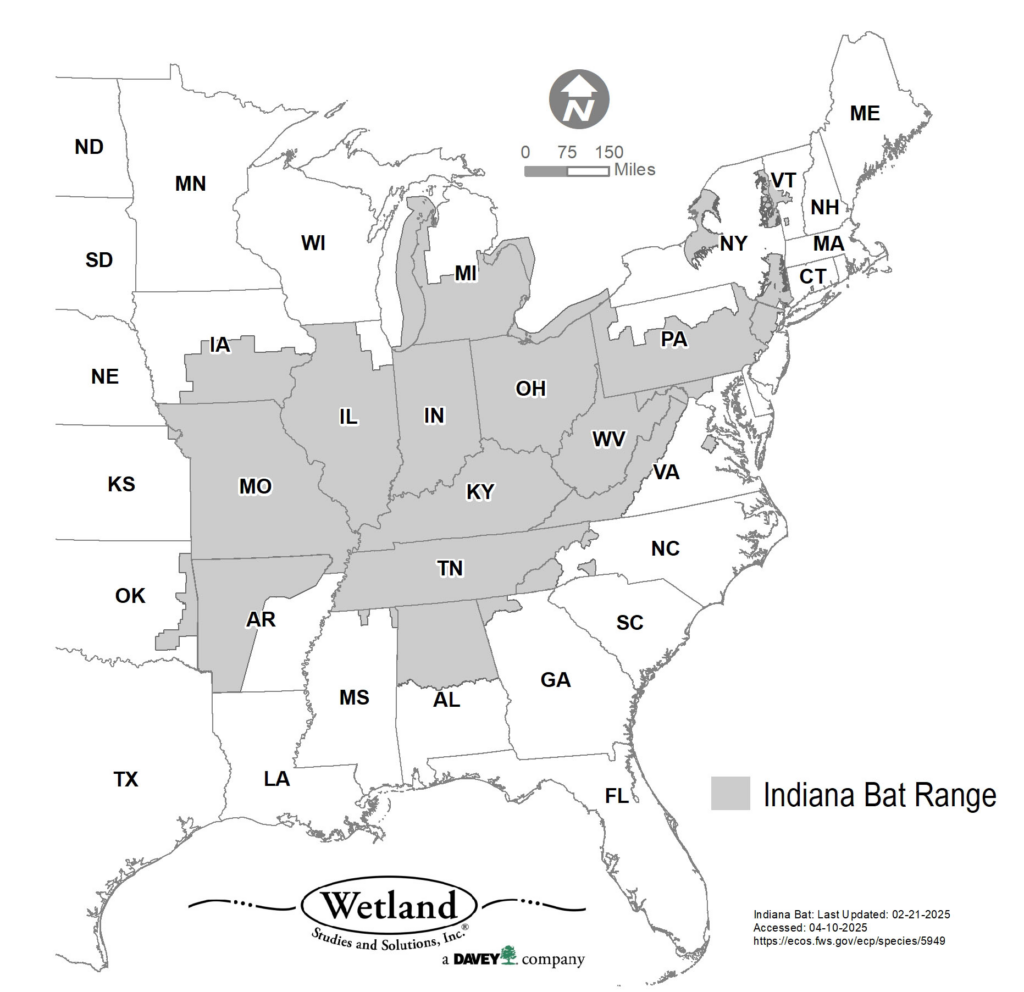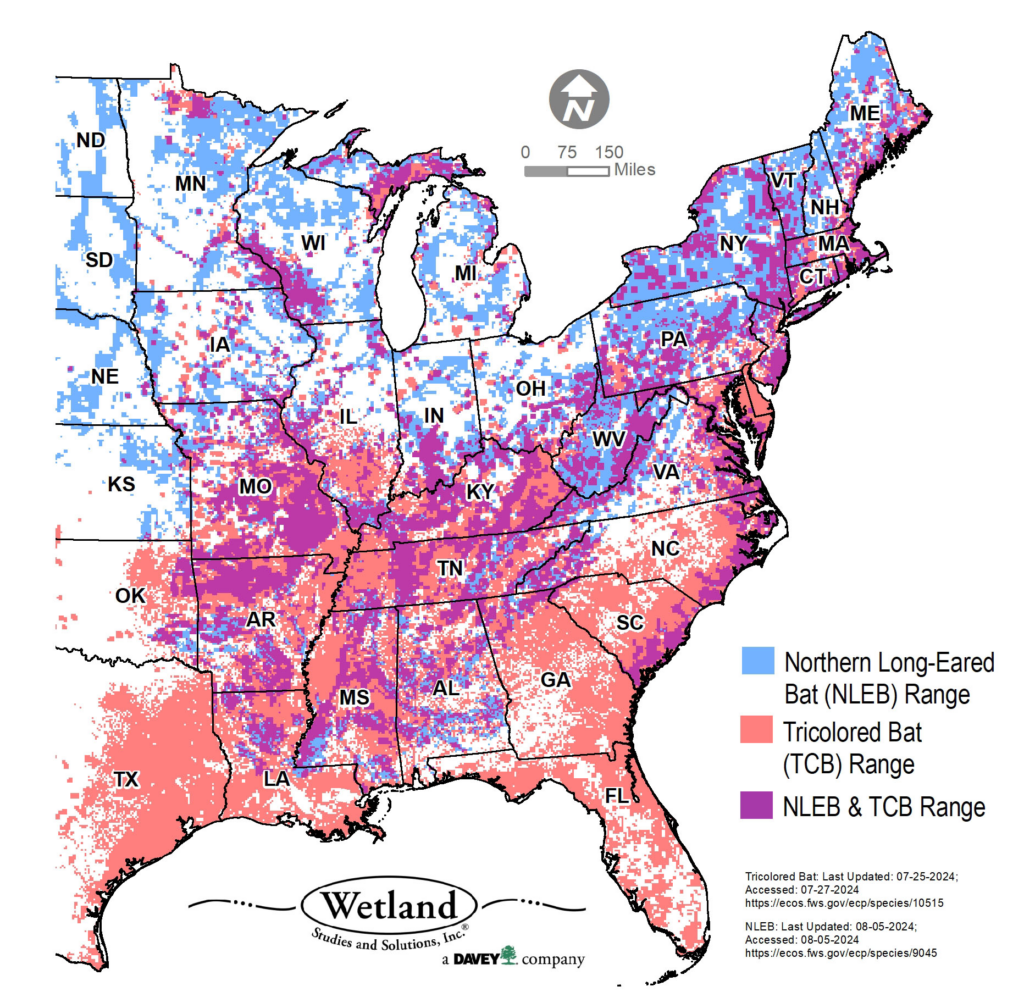Bats are emerging from their winter roosts as they transition to their breeding season in this warmer weather. If your projects are in the range of those bat species recognized as threatened or endangered under the Endangered Species Act, there may be certain conservation measures or protocols you need to follow.

Indiana bat regulations have not changed, but the range does increase as additional studies are conducted; projects not subject to protections previously may find that they are now or will be in the future.

This map shows the species for which USFWS has provided a Determination Key, Northern Long-eared Bat and Tricolored Bat.
Survey Guidelines and Windows
The U.S. Fish and Wildlife Service (USFWS) indicated on their website on March 25, 2025 that no formal updates to the Range-wide Indiana Bat & Northern Long-eared Bat Survey Guidelines would be published this year. However, they did update their list of Automated Acoustic Bat ID Software Programs and released a new study plan form. The 2024 Survey Guidelines, which also cover the tricolored bat, remain valid for the 2025 survey season.
The survey window for these listed bats opens on May 15 for areas within the hibernating range and runs until August 15. For areas where bats are active year-round, the season is extended and is open from March 1 through October 15.
Culvert and Bridge Assessments
The 2024 Survey Guidelines included a new appendix regarding bridge and culvert assessments. These assessments can be conducted any time of year and are valid for two years but may need to be repeated if activities involving the bridges or culverts will be performed in a different season (i.e., a winter assessment could be required for winter work). Culverts may be considered suitable habitat if they are greater than 23-feet long and greater than 3-feet in diameter at a minimum (exact diameter is species-dependent). Any bridges that are safe to assess are considered suitable habitat. These assessments may need to be conducted prior to completion of the Determination Key.
Determination Key Updates
Last year the USFWS published the Northern Long-eared Bat and Tricolored Bat Assisted Determination Key that addressed effects to both the northern long-eared bat (NLEB) and the tricolored bat (TCB) (click here to read our related Field Notes article). Projects can be deemed eligible for a predetermined “no effect” or “not likely to adversely affect” determination depending on project activities.
Notably, within the key there are questions in which project proponents can voluntarily adhere to time of year restrictions on tree clearing for each species. If the project activities are not eligible for a predetermined outcome in the key, then a “may affect” preliminary determination will be received, and further review by USFWS is needed.
Activities that may affect the outcome of the determination key – besides tree clearing – include impacts to existing bridges and culverts, drilling or blasting, overhead lighting, and road construction.
Time of Year Restrictions (TOYR)
TOYR windows are listed by state within Appendix L of the Survey Guidelines.

Indiana Bat
If your project is within a county where the federally endangered Indiana bat is known to hibernate or roost (see map above), project proponents must coordinate with the USFWS prior to clearing trees during any time of year. This species is protected during the summer months within suitable summer habitat, and in the winter months near their known hibernacula.
Northern Long-Eared Bat (NLEB)
For all projects which intersect the range for the federally endangered NLEB, project proponents should complete the newly released Determination Key to determine if the project will have an effect on the species. Projects with a “May Affect” preliminary determination will need to coordinate further with the USFWS to determine what conservation measures may be necessary to implement for the project. It is likely that the conservation measures will include a TOYR (no tree clearing) during the summer occupancy season in the hibernating range or winter torpor and summer occupancy in the year-round active range.
Tricolored Bat (TCB)
For all projects which intersect the range for the federally proposed endangered TCB, project proponents can complete the newly released USFWS Determination Key to determine if the project will have an effect on the species. Projects with a “May Affect” preliminary determination can propose a TOYR on tree clearing during the pup season in the hibernating range or the winter torpor and pup season in the year-round active range.
A final rule listing the TCB as an endangered species under the ESA has not yet been published by the USFWS. Once the rule is published in the Federal Register, it may take 30-90 days to become effective.
Need Help? Just call our bat experts!
Wetland Studies and Solutions can help you determine if your project:
- Is in an area where threatened or endangered bats are known to hibernate or roost,
- Requires coordination with federal and state agencies,
- Can be phased to work around time of year restrictions,
- Would benefit from the development of a Conservation Plan, or
- Would benefit from completion of a bat survey.
To discuss your project and your next steps for compliance with bat protection regulations, or for more information about any of our bat services, contact your project manager or the staff listed below.
